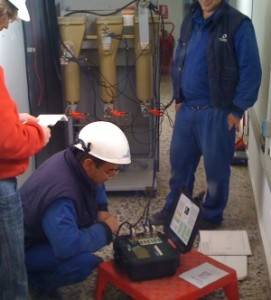Solutions for Contact Resistance Test
The contact resistance is the resistance to the current flow in electrical connections, due to surface conditions in the connection o contact surface, which may lead to poor or bad connection if it is too high, causing different problems in the circuit. Therefore, the contact resistance test measures the resistance of electrical connections in switching devices, breakers, relays, joints, connectors, etc, for finding bad or corroded contacts as a preventive method, or for diagnosis and problem solving.
The contact resistance test is very important for contacts that carry large amounts of current (e.g. circuit breakers, busbars, cable joints, etc) as higher contact resistance leads to higher losses, lower current carrying capacity and dangerous hot spots in the substation, so that the contact resistance test is used for detecting and preventing future problems, checking the circuit or equipment condition.
Typical method for contact resistance test
 The four-wires (Kelvin) DC voltage drop is the typical method used by micro-ohmmeters for the contact resistance test, which ensures more accurate measurements by eliminating the own contact resistance and resistance of test leads. The contact resistance test is performed using two current connections for the injection, and two potential leads for the voltage drop measurement; the voltage cables must be connected as closer as possible to the connection to be tested, and always inside the circuit formed by the connected current leads. From the measurement of the voltage drop, the microprocessor controlled micro-ohmmeters calculate the contact resistance, while eliminates the possible errors due to thermal EMF effects in the connections; thermal EMFs are small thermocouple voltages which are generated when two different metals are joined together, they will be added to the total voltage drop measured, and will introduce errors into the contact resistance test if they are not subtracted from the measurement through different methods (reversal of polarity and averaging, directly measuring of thermal EMFs magnitude, etc)
The four-wires (Kelvin) DC voltage drop is the typical method used by micro-ohmmeters for the contact resistance test, which ensures more accurate measurements by eliminating the own contact resistance and resistance of test leads. The contact resistance test is performed using two current connections for the injection, and two potential leads for the voltage drop measurement; the voltage cables must be connected as closer as possible to the connection to be tested, and always inside the circuit formed by the connected current leads. From the measurement of the voltage drop, the microprocessor controlled micro-ohmmeters calculate the contact resistance, while eliminates the possible errors due to thermal EMF effects in the connections; thermal EMFs are small thermocouple voltages which are generated when two different metals are joined together, they will be added to the total voltage drop measured, and will introduce errors into the contact resistance test if they are not subtracted from the measurement through different methods (reversal of polarity and averaging, directly measuring of thermal EMFs magnitude, etc)
It is very important in the contact resistance test to maintain consistent measurement conditions, to be able to compare with previous and future results for trending analysis. Therefore, when taking periodic measurements, the contact resistance test must be performed in the same position, with the same test leads (always with the calibrated cables supplied by the manufacturer), and in the same conditions, to be able to know when a joint, connection, weld or device will become unsafe and makes necessary the repair or maintenance jobs.
Different EuroSMC solutions for contact resistance test
EuroSMC offers different solutions for this application. The purpose of the contact resistance test, the current injection and measurement range, portability, the ease of operation, the availability of other joint testing and the contact resistance test in single or 3-phase, will determine the suitable selection for every need:
- PME-500-TR: combining two test sets in one, providing in the same report the timing and synchronization of the circuit breaker poles, and the 3-phase contact resistance test. The circuit breaker analyzer PME-500-TR evaluates the condition of the breaker in an easy to use instrument, PC independent, with just 8 kg, including rechargeable battery. The PME-500-TR automatically measures the contact resistance of the three breaker’s poles at a regulated 10 Adc with a resolution of 0.1 μΩ and an accuracy of 1%. This is achieved under microprocessor-controlled injection to compensate and cancel the thermocouple effect from the contact surfaces. Furthermore, the contact resistance test results are collected along with the rest of the analysis data, which saves testing time. The PME-500-TR can be used as regular 3-phase microohmeter for the diversity of contact resistance test applications.
The optional PME-Resc fast measurement clamps saves also time and mistakes for measuring time and resistance in many circuit breakers. With these Kelvin clamps the users just handle six connections instead of twelve, with an stronger grab to reduce the risk of disconnections, especially in outdoor breakers with heavier 11-m connections.
 New PRIME 600: the top range of µΩmeter in the market, pure DC with smart control up to 600 A, also including Dynamic Resistance Measurement, Dual Ground, and wireless remote control, an ideal choice for contact resistance test in circuit breakers. When the circuit breaker is in bad shape the values of the static contact resistance test will change dramatically from initial values, which make essential this measurement. Moreover, measuring the dynamic resistance during the opening and closing will indicate the wear of the arcing contacts. The new PRIME is the only microohmeter that combines both static and dynamic resistance measurements, as it is essential for assessing the actual condition of the contacts in inaccessible SF or vacuum chambers.
New PRIME 600: the top range of µΩmeter in the market, pure DC with smart control up to 600 A, also including Dynamic Resistance Measurement, Dual Ground, and wireless remote control, an ideal choice for contact resistance test in circuit breakers. When the circuit breaker is in bad shape the values of the static contact resistance test will change dramatically from initial values, which make essential this measurement. Moreover, measuring the dynamic resistance during the opening and closing will indicate the wear of the arcing contacts. The new PRIME is the only microohmeter that combines both static and dynamic resistance measurements, as it is essential for assessing the actual condition of the contacts in inaccessible SF or vacuum chambers.
- RAPTOR: the Raptor System includes a template for contact resistance test, enhancing its multifunctionality. The Raptor includes phase angle meters in all measurements and outputs, so that through 4-wire method, and with high AC current injection, measures the impedance, from which is obtained the contact resistance measurement in breakers and other connections.
For more information, please check the related EuroSMC products for contact resistance test or contact us.
